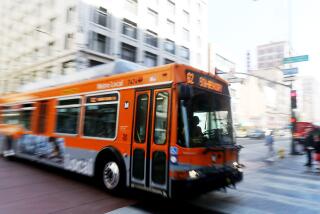LAPD set to add cameras to patrol cars
- Share via
After years of misfires and false starts, the Los Angeles Police Department is finally on the verge of installing digital video cameras in the first 300 of its patrol cars -- those used by officers in the South Bureau.
A test of four competing systems has led Police Chief William J. Bratton to recommend a contract with IBM Corp. for the first phase of a program that will eventually have the cameras installed in all 1,600 patrol cars citywide.
The video cameras will help hold officers accountable for their conduct and protect them against false accusations, said Alan Skobin, vice president of the Police Commission, which is expected to vote on awarding the $5-million contract to IBM on Tuesday.
“It’s an important step forward for the public and our officers, and we need to continue the momentum so we can implement this citywide as soon as possible,” Skobin said Saturday. “There are members of the public who don’t have a high confidence level in our officers and the system, and this will help with that.”
However, Skobin warned that the cameras might not capture everything in an incident, noting that the angle and scope of the shot might not provide the full picture.
Even so, the installation of cameras is endorsed by the union representing rank-and-file officers, with the qualifier that officers accused of misconduct have access to review the video evidence.
“It’s a good accounting of what happened at the scene,” Bob Baker, president of the L.A. Police Protective League, said Saturday. “A lot of time when there is a traffic stop, things are alleged by citizens that didn’t happen. I think it’s great for the officers, great for the community and great for the city.”
The cameras also may help the LAPD comply with a federal consent decree requiring efforts to prevent racial profiling in traffic stops, because there will be a video and audio record of every stop that can be reviewed by supervisors. Officers are fitted with wireless microphones that can pick up sound even when they leave the patrol car.
Police agencies began installing video cameras in patrol cars in the late 1980s. There were more than 17,500 such cameras in cars by 2004, about a quarter of them paid for with federal grants, according to the International Assn. of Chiefs of Police.
The LAPD decided to try in-car cameras shortly after the 1991 police beating of Rodney King was caught by an amateur photographer with a video camera.
The first camera was installed by then-Foothill Division Officer John Smith using his own money. It had some notable successes, including capturing on video the arrest of five men in the gang rape of a woman in a vacant lot. The tape was used to help identify the men in court.
Former Police Chief Daryl Gates approved an experimental program to install 22 cameras in patrol cars, but that was scaled back to seven cameras by his successor, Willie Williams.
The cameras were pulled out of the cars after their manufacturer went out of business and technical problems grew to be too daunting. Other departments that experimented with cameras early on also pulled the plug, citing the poor quality of the audio feed.
Mayor Antonio Villaraigosa and the City Council finally agreed last year to fund the cameras -- to be phased in over four years -- approving the first $5 million for the current year.
Eventually, the system of cameras and storage of digital images could cost $20 million to $25 million, but an LAPD report said the equipment could save the department $3 million a year in costs of investigating complaints.
In the report to be considered Tuesday by the Police Commission, Bratton said IBM’s $5-million bid was recommended after a demonstration project in which that firm and three leading competitors installed cameras in four patrol cars to test their performance.
The cameras are installed to hang down from the ceiling of the car near the rearview mirror and can pan to capture images to the side and rear of the car.
IBM is already used by the Beverly Hills Police Department and Santa Barbara County Sheriff’s Department.
“Both agencies are satisfied with the system and the vendor,” Bratton said in his report.
Sgt. Mike Foxen of the Beverly Hills Police Department said the cameras have several functions. Not only can cameras be used to verify the conduct of officers, but they can also help prove criminal cases.
“You can capture on tape when people run red lights,” he said. “And you can record what suspects are saying in the back seat after they are arrested. They come in pretty handy.”
*
More to Read
Sign up for Essential California
The most important California stories and recommendations in your inbox every morning.
You may occasionally receive promotional content from the Los Angeles Times.














